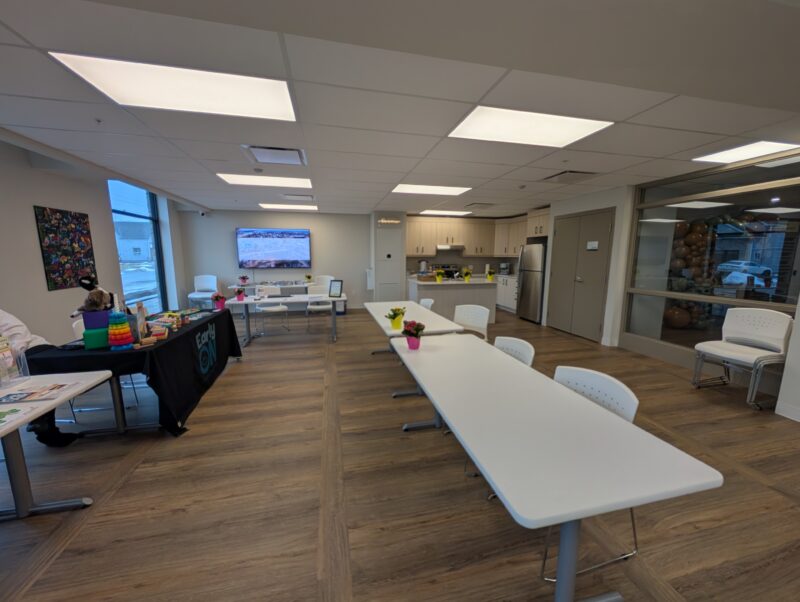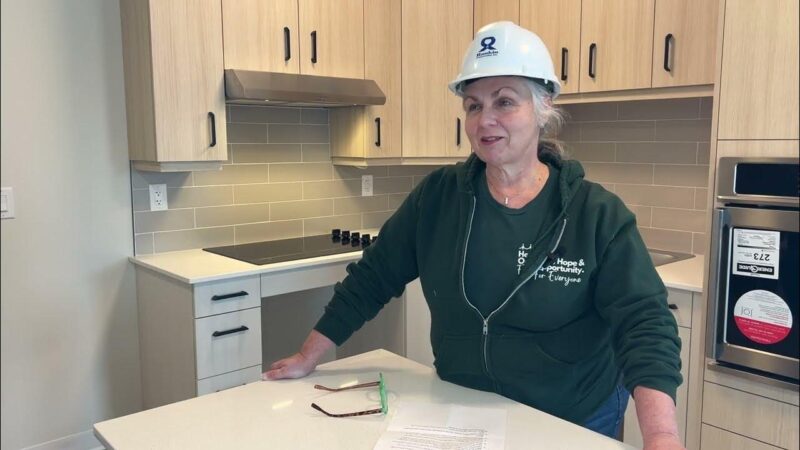A Q&A with Port Cares’ Christine Clark Lafleur
At Feed Ontario, we know how intertwined unaffordable housing and food insecurity are. That’s why we’re a part of the Fair Rent Ontario coalition, advocating for affordable housing and real rent control on a provincial level.
To highlight how important affordable housing is in local communities throughout the province, we talked to Christine Clark Lafleur, CEO of Port Cares, whose tireless work brought an incredible project to life: a 41-unit rent-geared-to-income apartment building created by Port Cares. Their organization saw the need for affordable housing and brought the local community together to make it happen.
The building, Chestnut Place, opened in February 2025. The units were designed to be not only energy-efficient, durable, and functional spaces to reduce upkeep and energy costs, but beautiful places to live. Large windows and nine-foot ceilings were incorporated to give the apartments lots of natural light, appealing high-quality cabinetry and fixtures were used, and a communal terrace was built to cultivate community and provide outdoor space for residents. These design choices were made so that Chestnut Place could be more than housing, but a community space where residents can take pride in their home.
This conversation has been edited for length and clarity.

The exterior of Chestnut Place near the end of construction.
Feed Ontario: As a food bank, why is affordable housing so important for your clients?
Christine Clark Lafleur: Well, affordable housing and food security go hand in hand – and this is not a new story.
The low-income households we serve are stuck between a rock and a hard place month after month, because they’re often faced with a choice between buying healthy food or making the full payment on their rent and utilities. And in the last three years in particular, food and rental costs have just exploded. You know, it’s simple math. You can no longer afford both.
We made the observation a number of years ago that you couldn’t relieve people of their reliance on the food bank without relieving the burden of the cost of keeping a roof over their head.
At the end of the day people and families want to have independence and autonomy, and the longer they’re stuck in the crunch of not being able to make choices because they don’t have the resources, the harder it is to get out of it.
So it made sense to us that to address the food security problem, you also had to address the housing problem.

The apartments in the building are furnished to make sure they’re accessible to those moving in.
Feed Ontario: What trends have you noticed in Port Colborne’s housing situation in the longer term – has there always been a lack of affordable housing, or is this a new issue the region is facing?
Christine Clark Lafleur: In this community there’s always been a low stock of rental housing, and there’s even less that’s affordable, which is a problem that’s been exacerbated over the years.
The genesis of the project was also related to safety, because we had a tragic fire in the community about eight years ago. A three-generation family perished in the fire, and it was because the housing they were living in wasn’t adequate.
It was a huge wake up call right in front of us. You have to find light in the darkness somewhere, and that light for us was being able to do something about it. If you really care about community, if you are a leader, you have a responsibility to do something about it to prevent future tragedies. If not you, then who.
If you really care about community, if you are a leader, you have a responsibility to do something about it to prevent future tragedies. If not you, then who.
Clearly our project doesn’t address the entire problem. It’s just a drop in the bucket, but it’s one more drop that’s there, and it can serve as a model for finding impactful, transformative ways of addressing the root of the problem.
Feed Ontario: What kind of housing supports was Port Cares previously providing, and how did they lead into this project?
Christine Clark Lafleur: We’ve provided an assortment of services that are all interconnected, and the housing development is just one more piece of the puzzle. Homelessness prevention is a critical program we provide – eviction prevention services, transitional housing, as well as community navigation and crisis intervention that includes income supports and referrals to medical services are all part of this.
When somebody comes into the food bank, we can wrap services around them right away. People come for basic needs, but what’s bringing them to us is far more complex than that – food is what starts the relationship of trust.
The community hub model and the assortment of services we provide allow the food bank to be an entry point where we can help with other needs, like employment, parenting support, or literacy.

One of the communal spaces at Chestnut Place, designed for residents to gather in.
Feed Ontario: How was Port Cares able to keep the rents in the building so affordable?
Christine Clark Lafleur: There’s no mortgage on the building. The construction was funded by a combination of local donations, revenue generation, and Port Cares’ own funding commitment. We also received a rapid housing initiative grant and a contribution from the Region of Niagara for affordable housing.
The building company was very philanthropic in that they absorbed a lot of the typical fees, keeping the cost of the construction lower.
The land was donated by the city – it is a real Cinderella story, but it’s certainly a testament to the need for this project and the confidence in our team.
It is a real Cinderella story, but it’s certainly a testament to the need for this project and the confidence in our team.
Feed Ontario: Since the building opened in February, what has the demand been like?
Christine Clark Lafleur: It’s a 41-unit building. I think if it were a 410-unit building, we’d still have people with interest. So, of course, we have a list of those who are interested and qualified, but it’s unfortunately far longer than what we’ve been able to accommodate.
Feed Ontario: What kind of impact have you seen both for those who have moved in and for the wider community?
Christine Clark Lafleur:
It’s important to nurture community, and a lot of these folks don’t have a lot of family or a support system. It’s been really wonderful to see that this building has really created an environment of care and community.
As I reflect on the project right now, it’s certainly been a hugely valuable aspect. When there’s social inclusion, there’s better outcomes for life, there’s better health. So, we’ve been able to address housing, health, the wrap around supports that people need, and the community is breaking down the barriers to social inclusion – and this is just five months in.
To learn even more about the story of Chestnut Place, regarder la vidéo Port Cares made about the project.
Food banks throughout the province are continuing to work hard to make sure their community has access to healthy food, and to work to address the root causes of why people need to turn to food banks in the first place. Our network is consistently finding new ways to help all of the multifaceted ways poverty affects those in need.
To learn more about how food banks are making a difference in your community, try our Trouver une banque alimentaire tool to find your local organization, and consider making a donation to Feed Ontario so we can continue supporting innovative local projects through our Feeding Possibility! Grant program.
